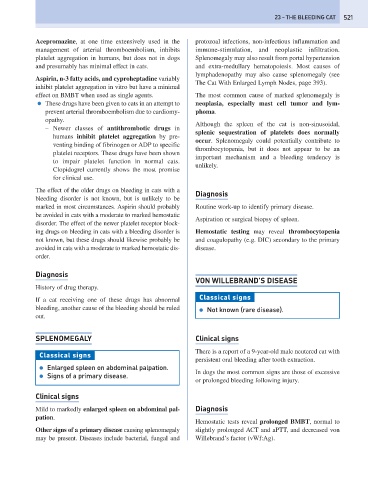Page 529 - Problem-Based Feline Medicine
P. 529
23 – THE BLEEDING CAT 521
Acepromazine, at one time extensively used in the protozoal infections, non-infectious inflammation and
management of arterial thromboembolism, inhibits immune-stimulation, and neoplastic infiltration.
platelet aggregation in humans, but does not in dogs Splenomegaly may also result from portal hypertension
and presumably has minimal effect in cats. and extra-medullary hematopoiesis. Most causes of
lymphadenopathy may also cause splenomegaly (see
Aspirin, n-3 fatty acids, and cyproheptadine variably
The Cat With Enlarged Lymph Nodes, page 393).
inhibit platelet aggregation in vitro but have a minimal
effect on BMBT when used as single agents. The most common cause of marked splenomegaly is
● These drugs have been given to cats in an attempt to neoplasia, especially mast cell tumor and lym-
prevent arterial thromboembolism due to cardiomy- phoma.
opathy.
Although the spleen of the cat is non-sinusoidal,
– Newer classes of antithrombotic drugs in
splenic sequestration of platelets does normally
humans inhibit platelet aggregation by pre-
occur. Splenomegaly could potentially contribute to
venting binding of fibrinogen or ADP to specific
thrombocytopenia, but it does not appear to be an
platelet receptors. These drugs have been shown
important mechanism and a bleeding tendency is
to impair platelet function in normal cats.
unlikely.
Clopidogrel currently shows the most promise
for clinical use.
The effect of the older drugs on bleeding in cats with a
Diagnosis
bleeding disorder is not known, but is unlikely to be
marked in most circumstances. Aspirin should probably Routine work-up to identify primary disease.
be avoided in cats with a moderate to marked hemostatic
Aspiration or surgical biopsy of spleen.
disorder. The effect of the newer platelet receptor block-
ing drugs on bleeding in cats with a bleeding disorder is Hemostatic testing may reveal thrombocytopenia
not known, but these drugs should likewise probably be and coagulopathy (e.g. DIC) secondary to the primary
avoided in cats with a moderate to marked hemostatic dis- disease.
order.
Diagnosis
VON WILLEBRAND’S DISEASE
History of drug therapy.
Classical signs
If a cat receiving one of these drugs has abnormal
bleeding, another cause of the bleeding should be ruled ● Not known (rare disease).
out.
SPLENOMEGALY Clinical signs
There is a report of a 9-year-old male neutered cat with
Classical signs
persistent oral bleeding after tooth extraction.
● Enlarged spleen on abdominal palpation.
In dogs the most common signs are those of excessive
● Signs of a primary disease.
or prolonged bleeding following injury.
Clinical signs
Mild to markedly enlarged spleen on abdominal pal- Diagnosis
pation.
Hemostatic tests reveal prolonged BMBT, normal to
Other signs of a primary disease causing splenomegaly slightly prolonged ACT and aPTT, and decreased von
may be present. Diseases include bacterial, fungal and Willebrand’s factor (vWf:Ag).

